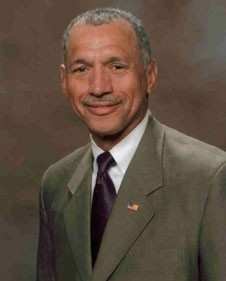'A $17.7 Billion Investment In Our Nation's Future' The Administrator Says
NASA administrator Charles Bolden on Wednesday said that President Obama's proposed budget for his agency for FY1014 is " a $17.7 billion investment in our nation's future." Bolden said the budget ensures the United States will remain the world's leader in space exploration and scientific discovery for years to come, while making critical advances in aerospace and aeronautics to benefit the American people.

"This budget focuses on an ambitious new mission to expand America's capabilities in space, steady progress on new space and aeronautic technologies, continued success with commercial space partnerships, and far-reaching science programs to help us understand Earth and the universe in which we live," Bolden said in a prepared statement. "It keeps us competitive, opens the door to new destinations and vastly increases our knowledge.
"Our drive to make new discoveries and dare new frontiers continues to improve life for people everywhere and raise the bar of human achievement."
Bolden said the space station remains the centerpiece of NASA's human exploration efforts. It allows the agency to perform technology demonstrations and scientific research only possible in microgravity, all while helping to improve life here on Earth and plan for missions into deep space.
"With America now successfully resupplying the International Space Station with cargo launched from the U.S. by American companies, this budget ensures that our astronauts will also be launched from U.S. soil on spacecraft built by American industry within the next four years, ending our reliance on other nations and opening up new commercial markets in space," he said.
"We are developing a first-ever mission to identify, capture and relocate an asteroid. This mission represents an unprecedented technological feat that will lead to new scientific discoveries and technological capabilities and help protect our home planet. This asteroid initiative brings together the best of NASA's science, technology and human exploration efforts to achieve the president's goal of sending humans to an asteroid by 2025. We will use existing capabilities such as the Orion crew capsule and Space Launch System (SLS) rocket, and develop new technologies like solar electric propulsion and laser communications -- all critical components of deep space exploration.
"NASA's ground-breaking science missions are reaching farther into our solar system, revealing unknown aspects of our universe and providing critical data about our home planet and threats to it. Spacecraft are speeding to Jupiter, Pluto and Ceres while satellites peer into other galaxies, spot planets around other stars, and uncover the origins of the universe. The budget funds our amazing fleet of scientific spacecraft, including strong support for study of the Earth and its response to natural or human-induced changes. And on the heels of the most daring mission to Mars in history last year, provides funding to launch another mission to the Red Planet. We also will continue our steady progress to develop and conduct critical tests on the James Webb Space Telescope, leading to its planned launch in 2018.
"While reaching for new heights in space, we're creating new jobs right here on Earth -- especially for the next generation of American scientists and engineers -- by supporting cutting edge aeronautics and space technology innovations and research and development that will help fuel the nation's economy for years to come."
Bolden's associate administrators echoed his praise, specifically for a manned mission to an asteroid.

"The mission to find, capture and redirect an asteroid robotically, and then visit it with astronauts to study it and return samples takes advantage of expertise across all of NASA in an integrated approach to exploration," said Associate Administrator for Human Exploration and Operations William Gerstenmaier (pictured). "Along with the scientific research and technology demonstrations happening around the clock on the International Space Station that are teaching us how humans can live and work in space, this mission will give us valuable experience we need in deep space operations to send humans to more distant destinations in the solar system, including Mars. Through the balance of this fiscal year, we will work to define an affordable mission architecture. In Fiscal Year 2014, NASA will begin developing and testing prototype capture mechanisms and concepts for crew interactions with the asteroid."
"The crucial first step in this endeavor is to enhance our ongoing efforts to identify and characterize near-Earth objects for scientific investigation and to find potentially hazardous asteroids and targets appropriate for capture," said Associate Administrator for Science John Grunsfeld. "The capture mission will be a highly visible and significant collaboration of robotic and human exploration in translunar space."
"This mission accelerates our technology development activities in high-powered solar electric propulsion," added Associate Administrator for Space Technology Michael Gazarik, also in a prepared release. "The ambitious mission to rendezvous, capture and redirect a small asteroid to Earth-moon space could not be accomplished without solar electric propulsion technology. This technology also will support the commercial telecommunications and satellite industries, and is an essential step toward future NASA human and robotic exploration forays into deep space."
 Airbus Racer Helicopter Demonstrator First Flight Part of Clean Sky 2 Initiative
Airbus Racer Helicopter Demonstrator First Flight Part of Clean Sky 2 Initiative Diamond's Electric DA40 Finds Fans at Dübendorf
Diamond's Electric DA40 Finds Fans at Dübendorf ANN's Daily Aero-Term (04.23.24): Line Up And Wait (LUAW)
ANN's Daily Aero-Term (04.23.24): Line Up And Wait (LUAW) NTSB Final Report: Extra Flugzeugbau GMBH EA300/L
NTSB Final Report: Extra Flugzeugbau GMBH EA300/L Classic Aero-TV: 'Never Give Up' - Advice From Two of FedEx's Female Captains
Classic Aero-TV: 'Never Give Up' - Advice From Two of FedEx's Female Captains




